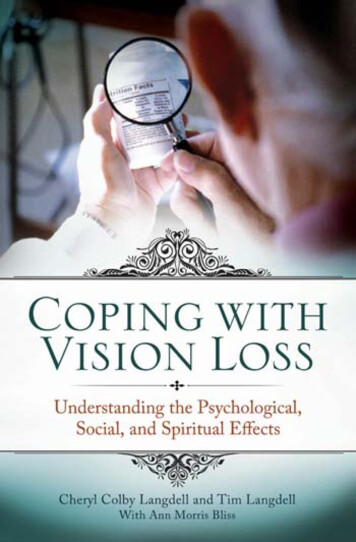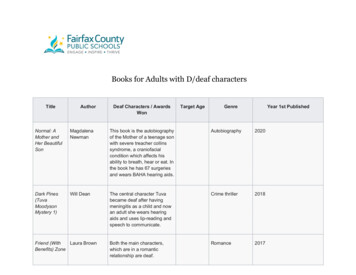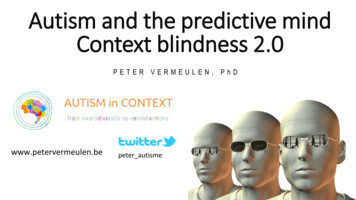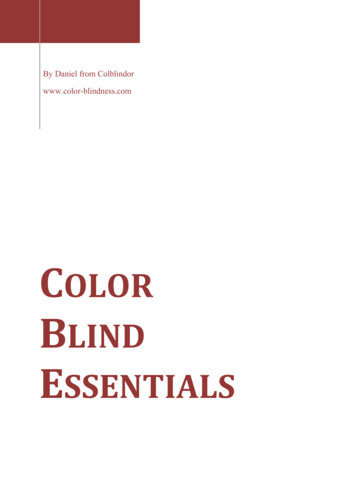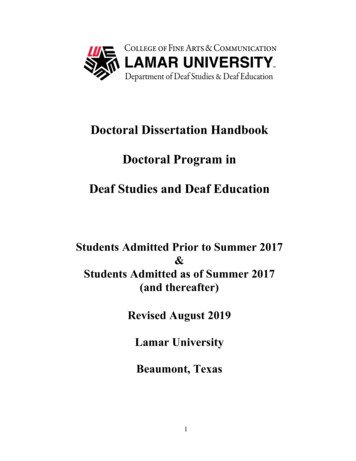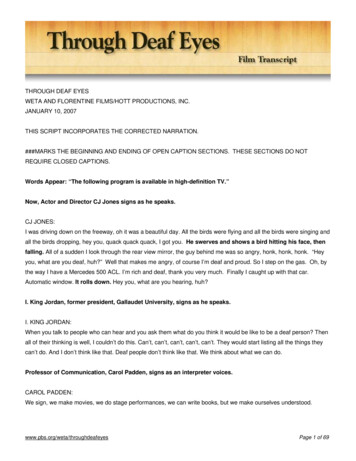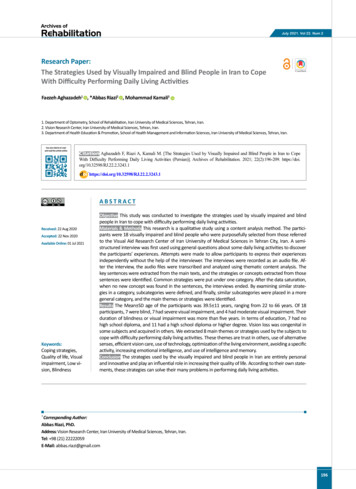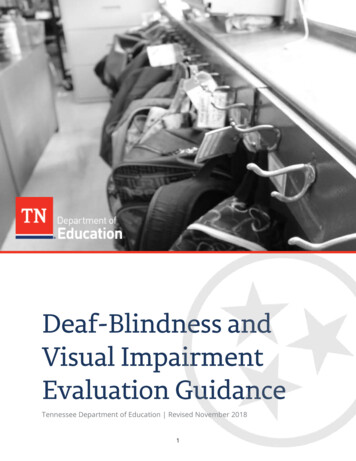
Transcription
Tennessee Department of Education Revised November 20181
AcknowledgementsThe department recognizes and appreciates all of the listed educational professionals, highereducation faculty, parents, and advocates contributed to the development of the DeafBlindness and Visual Impairment Evaluation Guidance for their time and effort.Kimberly MountjoyAndrea DitmoreRon CarliniMetro Nashville PublicOak Ridge SchoolsKnox County SchoolsDeanna ArnoldtLeslie JonesPamela GuessWilliamson County SchoolsThe ARC of Tennessee (West)University of Tennessee atSchoolsChattanoogaTressa FarrLaria RichardsonAlison GauldTennessee School for theThe ARC of TennesseeTennessee Department ofDeaf(Middle TN)EducationKatie KerleyLisa Rodden-PerinkaNathan TravisBradley County SchoolsWilson County SchoolsTennessee Department ofEducationAshley ClarkMelanie SchueleTheresa NichollsClarksville MontgomeryVanderbilt UniversityTennessee Department ofCounty SchoolsEducationRobin FairclothCathy BrooksJoanna BivinsHouston County SchoolsDisability Rights of TennesseeTennessee Department ofEducationKristina WolfeJenny WilliamsKristen McKeeverWest Tennessee School forTennessee DisabilityTennessee Department ofthe DeafCoalitionEducation2
Table of ContentsIntroductionSection I:Tennessee DefinitionSection II:Pre-referral and Referral ConsiderationsSection III:Comprehensive EvaluationSection IV:Eligibility ConsiderationsSection V:Re-evaluation ConsiderationsAppendix A:TN Assessment Instrument Selection FormAppendix B:Sample Eye ReportAppendix C:Preferred Visual Acuity NotationsAppendix D:Sample Release of InformationAppendix E:ResourcesAppendix F:Deaf-Blindness Assessment Documentation FormAppendix G:Visual Impairment Assessment Documentation Form3
IntroductionThis document is intended to provide school teams guidance when planning for student needs,considering referrals for evaluations, and completing evaluations/re-evaluations for educationaldisabilities. Disability definitions and required evaluation procedures and can be foundindividually on the Tennessee Department of Education website (here).1Every educational disability has a state definition, found in the TN Board of Education Rules andRegulations Chapter 0520-01-09,2 and a federal definition included in the Individuals withDisabilities Education Act (IDEA). While states are allowed to further operationally define andestablish criteria for disability categories, states are responsible to meet the needs of studentsbased on IDEA’s definition. Both definitions are provided for comparison and to ensure teamsare aware of federal regulations.The student must be evaluated in accordance with IDEA Part B regulations, and such anevaluation must consider the student’s individual needs, must be conducted by amultidisciplinary team with at least one teacher or other specialist with knowledge in the areaof suspected disability, and must not rely upon a single procedure as the sole criterion fordetermining the existence of a disability. Both nonacademic and academic interests mustcomprise a multidisciplinary team determination, and while Tennessee criteria is used, theteam possess the ultimate authority to make determinations.3IDEA Definition of Visual ImpairmentPer 34 C.F.R. §300.8(c)(13) Visual Impairment including blindness means “an impairment in visionthat, even with correction, adversely affects a child’s educational performance. The term includesboth partial sight and blindness.”IDEA Definition of Deaf-BlindnessPer 34 C.F.R. §300.8(c)(2), deaf-blindness means “concomitant hearing and visual impairment thecombination of which causes such severe communication and other developmental and educationalneeds that they cannot be accommodated in special education programs solely for children withdeafness or children with 331.pdf3Office of Special Education Programming Letter to Pawlisch, 24 IDELR 9594
Section I: Tennessee DefinitionTennessee Definitions of Visual Impairment and Deaf-BlindnessVisual Impairment, including blindness, means impairment in vision that, even withcorrection, adversely affects a child’s educational performance. The term includes both partialsight and blindness.Visual impairment includes at least one of the following:(1)(2)Visual acuity in the better eye or both eyes with best possible correction:(a)Legal blindness–20/200 or less at distance and/or near; or(b)Low vision–20/70 or less at distance and/or near.Visual field restriction with both eyes:(a)Legal blindness–remaining visual field of 20 degrees or less;(b)Low vision–remaining visual field of 60 degrees or less; or(c)Medical and educational documentation of progressive loss of vision, which mayin the future affect the student's ability to learn visually.(3)Other visual impairment, not perceptual in nature, resulting from a medicallydocumented condition (i.e., cortical visual impairment).Deaf-blindness means concomitant hearing and visual impairments, the combination of whichcauses such severe communication and other developmental and educational needs that theycannot be accommodated in special education programs by addressing any one of theimpairments. A child with deaf-blindness shall be:(1)A child who meets criteria for deafness/hearing impairment and visual impairment;4 and(2)A child who is diagnosed with a degenerative condition or syndrome which will lead todeaf-blindness, and whose present level of functioning is adversely affected by bothhearing and vision deficits; or(3)A child with severe multiple disabilities due to generalized central nervous systemdysfunction, and who exhibits auditory and visual impairments or deficits which are notperceptual in nature.See the Tennessee department of education’s evaluation and eligibility site for criteria related to deafness/hearing impairment: ion-evaluation-eligibility45
What does this mean?A visual impairment, including blindness, is a sensory impairment that, even with correction(e.g., prescription eyeglasses or contacts), adversely affects the child’s educational performanceand access to the educational, home, and community environments. The term includes lowvision, total blindness, visual field restrictions, progressive vision loss, and any other visualimpairment.5Blindness does not necessarily mean that a child cannot see anything. Legal blindness meansthat a student has acuity of 20/200 or less as measured by an optometrist or ophthalmologist.This number means that a person with 20/200 acuity, standing 20 feet from a target, seesapproximately the same thing as a person with 20/20 acuity standing 200 feet from the sametarget. People who are legally blind often can still read regular print with accommodations andoften can travel without assistance or the use of a white cane.Low vision is a term used to describe one’s vision when that individual has reduced visualacuity, even with glasses, surgery, or other medical treatment. The term “low vision” can beused to describe anyone with reduced visual acuity; even someone who reads braille may haveusable, functional vision that helps with daily tasks and therefore, would be said to have lowvision.In order for IEP teams to accurately determine whether a student meets Tennessee’s eligibilitycriteria, the medical eye report must include at least one of the following: visual acuity or an estimation of visual acuity, a statement about visual field, identification of medical eye condition that is progressive in nature, or identification of any other visual impairment (i.e., not perceptual in nature).Other visual impairments should also be considered, even with correction. An example of avisual impairment that is not perceptual in nature is a cortical visual impairment. Corticalvisual impairment describes a visual impairment due to damage to visual pathways or visualcenters in the brain. Diagnoses such as deficits in visual memory, visual perception, or visualmotor integration are not included in these criteria as they are perceptual in nature; theseprocesses do not occur in the visual centers or visual pathways of the brain.In order to meet the criteria for deaf-blindness, a child must meet the criteria for both a visualimpairment and deafness or demonstrate a syndrome or condition that is progressively leadingto the deafness and blindness.See the office of special education programs Memo from May 22, 56
For more information about various types of visual impairments, sualimpairment/.The state of Tennessee defines deafness as a profound hearing impairment so severe that thestudent is unable to comprehend verbal language and/or perceive sound in any form, with orwithout amplification. The student relies heavily on visual and/or kinesthetic and/or tactileinformation (e.g., lip reading, sign language, physical prompts, cued speech, and manipulatives).Deafness is the most severe form of hearing impairment. According to the NationalDissemination Center for Children with Disabilities, hearing loss above 90 decibels is considereddeafness, which means a hearing loss below 90 decibels is classified as a hearing impairment.6Hearing impairment is further defined as an impairment in hearing, whether permanent orfluctuating, in one or both ears, that negatively impacts detection and understanding of speechand perception of sound through the ear alone, thus preventing the student from participatingfully in classroom interaction and from benefiting adequately from school instruction.When analyzing the definition of deaf-blindness, several areas typically require clarification: amplification, communication, and adversely affects educational performance.AmplificationAmplification refers to the ability to amplify sounds to assist those with hearing loss. Examplesof amplification devices include hearing aids, cochlear implants, and FM devices.CommunicationCommunication is typically defined as the ability to use and comprehend language effectively.Adversely Affects a Child’s Educational PerformanceOne of the key factors in determining whether a student demonstrates an educationaldisability under IDEA and Tennessee special education rules is that the defined characteristicsof the disability adversely affect a child’s educational performance. The impact of thosecharacteristics must indicate s/he needs the support of specially designed instruction orservices beyond accommodations and interventions of the regular environment. Whenconsidering how to determine this, teams should consider if the student requires speciallydesigned instruction in order to benefit from his/her education program based on identifieddeficits that could impact a student’s performance such as the inability to communicateeffectively, significantly below-average academic achievement, the inability to independently6NICHCY is the National Dissemination Center for Children with Disabilities. Deafness and Hearing Loss factsheet (June, 2010) was retrieved from: epo items/fs3.pdf7
navigate a school building, or the inability to take care of self-care needs without support.Therefore, how disability characteristics may adversely impact educational performance appliesbroadly to educational performance, and teams should consider both quantity and quality ofimpact in any/all related areas (e.g., academic, emotional, communication, social, etc.).When thinking about deafness, the child’s educational performance may be additionallyadversely affected in one or more of the following areas: Inability to learn through auditory-focused modalities (e.g., lectures, classroomdiscussions, peer interactions, watching educational films) Inability to participate in orally based classroom activities (e.g., taking oral exams, givingpresentations, taking notes) Inability to communicate learned skills due to delayed language development inpreferred modality (e.g., speech, ASL, other sign language)Section II: Pre-referral and ReferralConsiderationsIt is the responsibility of school districts to seek ways to meet the unique educational needs ofall children within the general education program prior to referring a child to special education.By developing a systematic model within general education, school districts can providepreventative, supplementary differentiated instruction and supports to students.General Pre-Referral InterventionsStudents who have been identified as at risk will receive appropriate interventions in theiridentified area(s) of deficit. These interventions are determined by school-based teams byconsidering multiple sources of academic and behavioral data.One way the department supports prevention and early intervention is through multi-tieredsystems of supports (MTSS). The MTSS framework is a problem-solving system for providingstudents with the instruction, intervention, and supports they need with the understandingthere are complex links between students’ academic and behavioral, social, and personalneeds. The framework provides multiple tiers of interventions with increasing intensity along acontinuum. Interventions should be based on the identified needs of the student usingevidenced based practices. Examples of tiered intervention models include Response toInstruction and Intervention (RTI2), which focuses on academic instruction and support, andResponse to Instruction and Intervention for Behavior (RTI2-B). Within the RTI2 Framework andRTI2-B, academic and behavioral interventions are provided through Tier II and/or Tier IIIinterventions (see MTSS Framework, RTI2 Manual, & RTI2-B Manual).These interventions are in addition to, and not in place of, on-grade-level instruction (i.e., Tier I).It is important to recognize that ALL students should be receiving appropriate standards-based8
differentiation, remediation, and reteaching, as needed in Tier I, and that Tiers II and III arespecifically skills-based interventions.It is important to document data related to the intervention selection, interventions (includingthe intensity, frequency, and duration of the intervention), progress monitoring, interventionintegrity and attendance information, and intervention changes to help teams determine theneed for more intensive supports. This also provides teams with information when determiningthe least restrictive environment needed to meet a student’s needs.Cultural Considerations:Interventions used for EL students must include evidence-based practices for ELs.The Individuals with Disabilities Education Act (IDEA) ensures that children who have hearingloss receive free, appropriate early intervention programs from birth to age three andthroughout the school years (ages three to 21). According to American Speech-LanguageHearing Association (ASHA), early intervention services for infants and toddlers should befamily centered and designed to: Help the child stay on schedule with his/her speech, language, and communication skills Enhance understanding of the child’s hearing loss and special communication needs Support families in a way that helps them feel confident in raising a child with hearingloss Keep track of the child's progress and to make decisions for intervention and educationeach step of the way as the child developsEffective early intervention has been identified as one of the most successful avenues tosuccess for students who are deaf or hard of hearing comparable with their age peers. Infantsidentified with hearing loss can be fit with amplification as young as four weeks of age. Withappropriate early intervention, language, cognitive, and social development for these infants isvery likely to develop on par with hearing peers. Recent research has concluded that childrenborn with a hearing loss who are identified and given appropriate intervention prior to sixmonths of age have significantly better language skills than those identified after six months ofage. In Tennessee, the Tennessee Early Intervention System (TEIS) provides a statewide, homebased program for families of infants and toddlers aged birth to three. A trained parent advisorvisits in the home weekly to train and give support to parents utilizing a curriculum thatemphasizes communication skills, hearing aid management, auditory skills, language skills, anddevelopmental skills.Prevention and Intervention ConsiderationsIt is important for families to follow up with medical eye care professionals to obtaininformation related to acuity, underlying medical conditions, and any medical treatment thatmay improve their child’s visual functioning. Undiagnosed medical visual conditions or9
refractive errors can prevent a child from accessing his/her environment (i.e., seeing andindependently locating toys, social cues, peers, family, etc.). Early medical attention mayimprove a child’s visual access to the environment and therefore improve his ability to learnand develop skills commensurate with peers.Tennessee’s Early Intervention System (TEIS) provides support for families with children withdisabilities (ages birth to three years). Children with visual impairments may be eligible for earlyintervention services as they often demonstrate delays in motor skills, social skills, and adaptiveskills related to their visual impairment even after corrective lenses or medical care has beenprovided.For children in this program who are approaching their third birthday, if the team continues tosuspect the child is demonstrating a disability, parental consent for an evaluation to determineeligibility for special education and related services is required. The parents, school districtrepresentatives, and TEIS representatives should all participate in a transition planningconference arranged by TEIS, with the approval of the family, at least 90 days and no more thannine months prior to the child’s third birthday. IDEA states that children transitioning from PartC to Part B services must have an IEP in place by their third birthday.Tennessee’s School Health Screening Guidelines include information about when schoolsshould perform vision screenings, how to perform vision screenings, and how to appropriatelyfollow up with the family if a child fails a vision screening. The guidelines offer the followingjustification for school vision screenings: Unidentified and uncorrected vision problems and eye conditions can have adevastating impact on children’s development. Since an estimated 80 percent ofchildren’s learning occurs through visual processing, early detection is extremelyimportant. Another equally important reason is that some conditions are easier tocorrect at a young age, before irreversible vision damage occurs.A certified teacher of children with visual impairments (TVI) does not have to perform schoolvision screenings. School personnel may be trained to perform near and distant visionscreenings, trained volunteers may perform screenings, or schools may contract with outsideagencies to perform the screenings. Tennessee’s school health screening guidelines providedetailed instructions on how to perform vision screenings and what to do when a student fails avision screening. A TVI may be called to review a medical eye report provided by theoptometrist or ophthalmologist.According to Tennessee’s guidelines, a student fails a vision screening with acuity of 20/30 atnear or distant range, or a difference of two lines between the two on the eyes as measured onan eye chart (e.g., right eye 20/20, left eye 20/40). When students fail vision screenings, theschool shall recommend that the parent follow up with an eye doctor (i.e., an optometrist orophthalmologist).10
Community education is of the utmost importance when it comes to sensory impairments.Public schools must educate community agencies on the importance of early detection andengagement in appropriate early intervention services and timely referrals to appropriateprofessionals. These early detection measures can maximize a student’s learning potential.Interagency cooperation generates one of the most effective and efficient means of identifyingand locating children with suspected sensory impairments.Potential agencies for community outreach: Tennessee Early Intervention Systems (TEIS) Public health departments Department of human services (DHS) Department of children’s services (DCS) Headstart programs Child development centers Daycare centers Pediatricians’ offices Private preschool programs West Tennessee School for the Deaf Tennessee School for the Deaf Tennessee School for the BlindWhen planning classroom needs, the IRIS center provides resources for accommodations to thephysical environment for students with visual odule/v01-clearview/#content.An alternate way to support a child with a disability who does not require special educationservices, but whose condition substantially impacts the student’s daily functioning is throughallowable accommodations under Section 504. Section 504 is a federal law that protectsindividuals with disabilities. More information about Section 504 can be found aq.html.Background ConsiderationsWhen considering deaf-blindness or visual impairment as an eligibility category, there areseveral background areas to consider. Vision/hearing: As with all evaluations, vision and hearing screenings are integral piecesof the pre-referral and evaluation process. Ensuring typical vision helps teams focusintervention, determine possible causes of difficulty, and select appropriateassessments. The Tennessee School Health Screening Guidelines provide typicalscreening requirements and screening rationale. School teams should consider anyoutside hearing screening/examination results when determining possibleaccommodations and referral needs.11
Past performance: Another area of background information will need to includeconsideration of past educational interventions including speech, occupational therapy,physical therapy, and family intervention. The team should determine if the child hasundergone any evaluations that the team should review and consider. The team shouldreview all information provided by parents and specialists and consider if screeningand/or assessments are needed to determine if a child has a disability that needssupport through special education services. Medical history: The team will also want to gather information regarding the child’smedical history including birth and developmental information. Consideration of familyhistory and prenatal/postnatal significant history should also be considered. The timingand nature of potential medical complications could have lasting impacts on a child’sdevelopment.Referral Information - Documenting Important Pieces of the PuzzleWhen considering a referral for an evaluation the team should review all information availableto help determine whether the evaluation is warranted and determine the assessment plan.The following data from the general education intervention phase that can be used includes:(1) reported areas of concern (e.g., vision and hearing screening/evaluation results,challenges demonstrated in the school environment such as daily living skills,communication, orientation and mobility concerns, and social skills);(2) documentation of the problem;(3) provided medical history (including prescribed medications along with possible sideeffects) and/or outside evaluation reports; and(4) record of accommodations and interventions attempted along with results fromprogress monitoring.Section III: Comprehensive EvaluationWhen a student is suspected of an educational disability and/or is not making progress withappropriate pre-referral interventions that have increased in intensity based on studentprogress, s/he may be referred for a psychoeducational evaluation. A referral may be made bythe student's teacher, parent, or outside sources at any time.Referral information and input from the child’s team lead to the identification of specific areasto be included in the evaluation. All areas of suspected disability must be evaluated. In additionto determining the existence of a disability, the evaluation should also focus on the educationalneeds of the student as they relate to a continuum of services. Comprehensive evaluationsshall be performed by a multidisciplinary team using a variety of sources of information thatare sensitive to cultural, linguistic, and environmental factors or sensory impairments. Therequired evaluation participants for evaluations related to suspected disabilities are outlined in12
the eligibility standards. Once written parental consent is obtained, the school district mustconduct all agreed upon components of the evaluation and determine eligibility within sixty (60)calendar days of the district’s receipt of parental consent.Cultural Considerations: Culturally Sensitive Assessment PracticesIEP team members must understand the process of second language acquisition and thecharacteristics exhibited by EL students at each stage of language development if they are todistinguish between language differences and other impairments. The combination of dataobtained from a case history and interview information regarding the student’s primary orhome language (L1), the development of English language (L2) and ESL instruction, support athome for the development of the first language, language sampling and informalassessment, as well as standardized language proficiency measures should enable the IEPteam to make accurate diagnostic judgments. Assessment specialists must also considerthese variables in the selection of appropriate assessments. Consideration should be given tothe use of an interpreter, nonverbal assessments, and/or assessment in the student’sprimary language. Only after documenting problematic behaviors in the primary or homelanguage and in English, and eliminating extrinsic variables as causes of these problems,should the possibility of the presence of a disability be considered.English LearnersTo determine whether a student who is an English learner has a disability it is crucial todifferentiate a disability from a cultural or language difference. In order to conclude that anEnglish learner has a specific disability, the assessor must rule out the effects of differentfactors that may simulate language disabilities. One reason English learners are sometimesreferred for special education is a deficit in their primary or home language. No matter howproficient a student is in his or her primary or home language, if cognitively challenging nativelanguage instruction has not been continued, he or she is likely to demonstrate a regression inprimary or home language abilities. According to Rice and Ortiz (1994), students may exhibit adecrease in primary language proficiency through: inability to understand and express academic concepts due to the lack of academicinstruction in the primary language, simplification of complex grammatical constructions, replacement of grammatical forms and word meanings in the primary language bythose in English, and the convergence of separate forms or meanings in the primary language and English.These language differences may result in a referral to special education because they do not fitthe standard for either language, even though they are not the result of a disability. Theassessor also must keep in mind that the loss of primary or home language competencynegatively affects the student’s communicative development in English.13
In addition to understanding the second language learning process and the impact that firstlanguage competence and proficiency has on the second language, the assessor must be awareof the type of alternative language program that the student is receiving.The assessor should consider questions such as: In what ways has the effectiveness of the English as a second language (ESL) instructionbeen documented? Was instruction delivered by the ESL teacher? Did core instruction take place in the general education classroom? Is the program meeting the student’s language development needs? Is there meaningful access to core subject areas in the general education classroom?What are the documented results of the instruction? Were the instructional methods and curriculum implemented within a sufficient amountof time to allow changes to occur in the student’s skill acquisition or level?The answers to these questions will help the assessor determine if the language difficulty is dueto inadequate language instruction or the presence of a disability.It is particularly important for a general education teacher and an ESL teacher/specialist to worktogether in order to meet the linguistic needs of this student group. To ensure ELs are receivingappropriate accommodations in the classroom and for assessment, school personnel shouldconsider the following when making decisions: Student characteristics such as:oOral English language proficiency leveloEnglish language proficiency literacy leveloFormal education experiencesoNative language literacy skillsoCurrent language of instructionInstructional tasks expected of students to demonstrate proficiency in grade-levelcontent in state standards Appropriateness of accommodations for particular content areas*For more specific guidance on English learners and immigrants, refer to the English as aSecond Language Program Guide (August 2016).Section IV: Eligibility DeterminationConsiderationsAfter completion of the evaluation, the IEP team must meet to review results and determine ifthe student is eligible for special education services. Eligibility decisions for special educationservices is two-pronged:
sight and blindness. Visual impairment includes at least one of the following: (1) Visual acuity in the better eye or both eyes with best possible correction: (a) Legal blindness–20/200 or less at distance and/or near; or (b) Low vision–20/70 or less at distance

